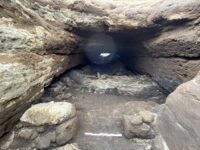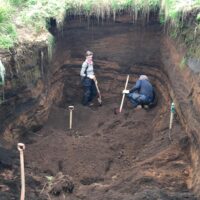 A man-made cave near Oddi in South Iceland is much older and larger than archaeologists initially realized. An analysis of the layers of volcanic tephra revealed that the caves were created in the middle of the 10th century, not in the early 12th century as previously believed.
A man-made cave near Oddi in South Iceland is much older and larger than archaeologists initially realized. An analysis of the layers of volcanic tephra revealed that the caves were created in the middle of the 10th century, not in the early 12th century as previously believed.
The first of the caves was discovered in 2018 and then a second larger one was found to be connected to it. The current research team has been excavating the caves since 2020. The larger cave of the two was collapsed, forcing archaeologists to dig deeper to get access to the cave in the safest possible conditions in a challenging environment with crumbling sandstone walls. So far it has only been partially opened.
 The investigation into the cave system is part of a larger exploration of the literary culture that thrived in Oddi during the 11th and 12th century. The Oddverjar clan who lived there were famed as historians, poets and authors of some of the most important Norse sagas, including the Heimskringla. There may even be a direct reference to the caves in one of those sagas.
The investigation into the cave system is part of a larger exploration of the literary culture that thrived in Oddi during the 11th and 12th century. The Oddverjar clan who lived there were famed as historians, poets and authors of some of the most important Norse sagas, including the Heimskringla. There may even be a direct reference to the caves in one of those sagas.
Kristborg says that the cave currently being excavated may possibly be Nautahellir, Bull Cave, which is mentioned in Jarteinabók Þorláks Biskups (Bishop Þorlákur’s Legends of Saints), which dates back to 1210 – 1250. The manuscript relates how Nautahellir collapsed with 12 bulls in it. One was then rescued from the rubble.
“Although it’s older than that, it’s likely that [the cave] was used for livestock,” explained Kristborg. “Whether it was for that specific bull, we don’t know. But the history of its use obviously goes back further than we’ve managed to trace yet.”
The caves at Oddi have a complex and fascinating story to tell, says Kristborg, but the scope of the current investigation is such that she and her team need to keep their focus narrow. “These are huge structures and an unbelievably large system of caves that we’re only just starting to come to grips with. […] We’d need to undertake a much, much larger study with a much bigger crew in order to get to the bottom of this and trace this history in full, the history of these caves’ use.”
Here is a 3D scan fly-through of the cave:
“There was a Saxon priest in Olaf’s house who was called Thangbrand (“Þangbrandr”), a passionate, ungovernable man, and a great manslayer; but he was a good scholar, and a clever man.” –King Olaf Trygvason’s Saga (80). Þangbrandr’s mission in Iceland began in 997, and maybe they knew, whom they were sending.
:hattip:
Once in Iceland, Greenland was found and “Thule”, and from there, apparently the Americas. According to the “Gesta Hammaburgensis ecclesiae pontificum”, written before 1085AD, Bk.IV.39:
———
“The round globe makes the course of the accessing sun bring day, and else the recessing sun leave night. At summer solstice, it prolongates the days and shortens the nights to those that are in the North; and while it descends to winter solstice, it brings the corresponding to those in the South. Unaware of that, the pagans call that land holy and happy, because it presents those miracles to the mortals. This has now been confirmed by the king of the Danes and many others happening there as it does in Sweden and in Norway and the rest of the islands over there.
Also, he talks about a newly found island among the many in that ocean, which is referred to as ‘Winland’, because grapevine grows there on its own, bearing the best vines. That over there the abundant crops are not sown, we get to know not only from fanciful opinion but from the true account of the Danes. Beyond that island, he says, habitable land is not found in that ocean, instead all territories beyond are full of intolerable ice and immense fog.
On this, Martianus comments as follows: One day of sailing beyond Thule, he says, the sea is frozen. Harald, the most enterprising leader of the Normans, recently tried that. He who searched with his ships the northern latitude at last backed down safely from the nebulous harsh extreme end of the world, hardly avoiding tha vast abyss of Hell by reversing his track…”
———
“Nam propter rotunditatem orbis terrarum necesse est, ut solis circuitus accedens alibi diem exhibeat, alibi recedens noctem relinquat. Qui dum ascenderit ad aestivale solsticium, his qui in borea sunt dies prolongat noctesque adbreviat; descendens autem ad hiemale solsticium, simili ratione facit australibus. Hoc ignorantes pagani, terram illam vocant sanctam et beatam, quae tale miraculum praestet mortalibus. Itaque rex Danorum cum multis aliis contestatus est hoc ibi contingere, sicut in Suedia et in Norvegia et in ceteris quae ibi sunt insulis.
Praeterea unam adhuc insulam recitavit a multis in eo repertam oceano, quae dicitur ‘Winland’, eo quid ibi vites sponte nascantur, vinum optimum ferentes. Nam et fruges ibi non seminatas habundare, non fabulosa opinione, sed certa comperimus relatione Danorum. Post quam insulam, ait, terra non invenitur habitabilis in illo oceano, sed omnia, quae ultra sunt, glacie intolerabili ac caligine immensa plena sunt.
Cujus rei Martianus ita meminit: Ultra Thulen, inquiens, navigatione unius diei mare concretum est. Temptavit hoc nuper experientissimus Nordmannorum princeps Haraldus. Qui latitudinem septentrionalis oceani perscrutatus navibus tandem caligantibus ante ora deficientis mundi finibus, inmane baratrum abyssi retroactis vestigiis vix salvus evasit…”
———